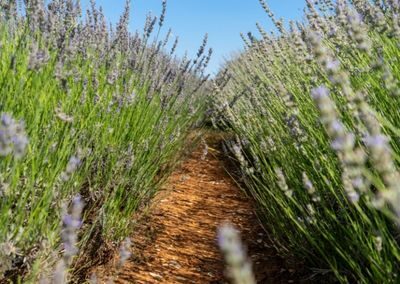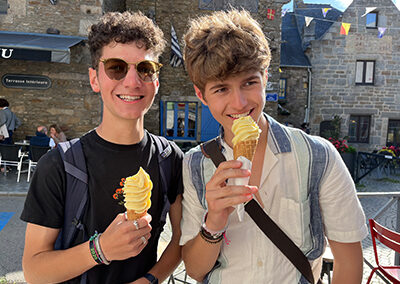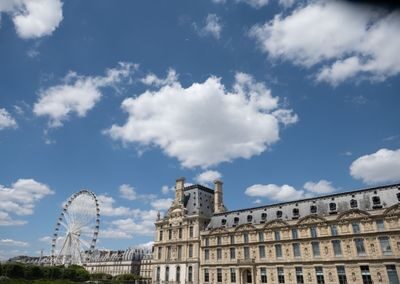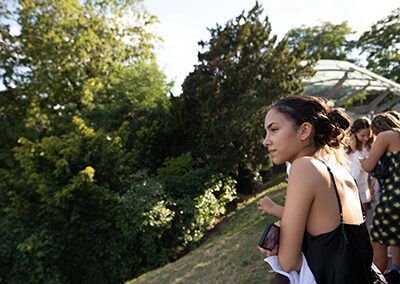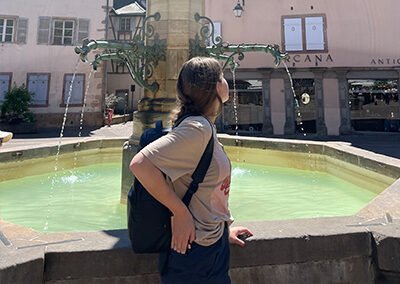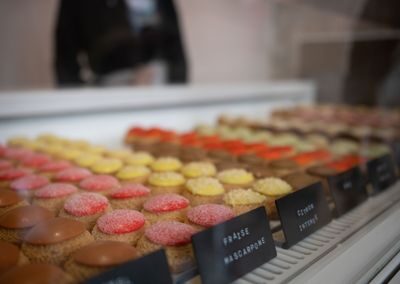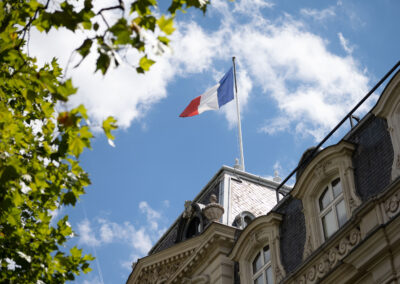Smithsonian Student Travel | France | NEW
Highlights
-
See some of the world’s most compelling prehistoric cave paintings
-
Kayak below cliff top castles on the Dordogne River
-
Interpret the stained glass of Chartres Cathedral with a renowned historian
-
Learn from farmers using ancient biodynamic practices to produce goat cheese and olive oil
Itinerary
This itinerary represents our plan for the program. However, we may implement changes if we identify opportunities to improve the experience, to take advantage of unexpected events, or to accommodate local schedule changes.
Departure • Travel Day • Meet your student travel group and one of your trip leaders in New York, and fly together to Bordeaux, France.
The Dordogne Valley • 4 days • Transfer directly to our small hotel in nearby Sarlat, the heart of the Dordogne. Dive into prehistory in the valleys of the Dordogne and Vézère rivers, exploring kilometers-long caves deep underground at Pech Merle, and visit meticulously reproduced cave paintings at Lascaux IV to see the architecture and art of those who preceded us by 20,000 years. Your Smithsonian Student Travel Expert joins this portion of the program to bring context to the ancient history and cave art for which this region is renowned. Kayak below extraordinary castle-topped cliffs and cool off by swimming in deep river pools. Explore the charming towns of Sarlat and Les Eyzies. Shop for your picnic in farmers’ markets using French language skills you bring or pick up along the way.
Albi & the Tarn • 4 days • Continue south past the Lot valley to Albi, a UNESCO World Heritage site, built on the banks of the Tarn river. Renowned for its brick architecture, Albi Cathedral is the largest brick building in the world, built as a church, but also as a fortress in the aftermath of the 13th century crusade against the Albigensian Cathars, at a time when Catholics suppressed a religious schism and sought to convey their dominance through architecture. Settle into a family-run hotel on one of Albi’s many charming squares and use it as a base to wander through small walking streets, the bustling market, exquisite cloister gardens, and along the banks of the river. Visit the museum of the painter Henri de Toulouse-Lautrec, born in Albi. Climb over the ruins and fortresses of the Cathars wars in some of France’s most beautiful hilltop medieval villages, like Cordes-sur-Ciel and Penne. Dive into the farm-to-table movement, meeting with organic and biodynamic farmers gaining worldwide acclaim for reintroducing ancient farming techniques to produce extraordinary cheese, olive oil, and more. Help break down fresh fruit that will be distilled by wood fires to make eau-de-vie exported to the finest restaurants of New York and Tokyo. Meet a master chocolatier and watch them create delicacies right before your eyes, and use your French to negotiate ingredients for your group’s lunch in the weekly market at Saint-Antonin-Noble-Val, then picnic with your fellow travelers on the cliffs overlooking the Aveyron.
Paris • 5 days • Travel by train to Paris where you meet art historians in the museums of the Louvre, Musée d’Orsay, the Musée Rodin, and the Centre Pompidou, and with historians at Cathedral de Chartes and Les Invalides and its Musée de l’Armée. Stay in a renovated maison particulier hostel in the heart of Le Marais, within walking distance of the Ȋle de la Cité, the Quartier Latin, and much of the heart of Paris. Wander through Les Jardins du Luxembourg, shop-lined streets, flea markets, and thrift stores. Celebrate the end of this deep dive into tradition and history with a trend-setting meal with your new friends in a Michelin-starred restaurant.
Return • Travel Day • Fly from Paris, France, to New York with your group and a trip leader, then continue on to your final destination.
Smithsonian Student Travel Experts
The expert(s) highlighted below are examples of professionals that will join the group at various points throughout the itinerary to add their expertise and insight to the program theme.

April Nowell, Archaeologist
Dr. April Nowell is a Paleolithic archaeologist and Professor of Anthropology at the University of Victoria, Canada, where she has taught classes on cave art for more than 20 years. She received her BA from McGill University and her PhD from the University of Pennsylvania. She directs an international team of researchers in the study of Lower and Middle Paleolithic sites in Jordan and collaborates with colleagues on the study of cave art in Australia and France and on ostrich eggshell beads in South Africa. Her work has been covered by more than 100 outlets including The Washington Post, The Guardian, The New York Times, CNN website, The Economist, CBC’s The National and As It Happens, NPR, and the Smithsonian Magazine website, and her work on blood residue on stone tools was named one of Time Magazine’s top 100 discoveries. Her most recent book is titled Growing Up in the Ice Age: Fossil and Archaeological Evidence of the Lived Lives of Plio-Pleistocene Children.
April will be joining both France departures.
Watch a Previously Recorded Webinar
What to Expect
Physical Activity • This is a physically active summer travel program. You can expect to kayak down rivers, hike to ruins on hilltops in summer sun, and walk significant distances through the city streets of Paris over the course of the trip. You do not need to be at peak fitness to participate, but it is important that you have a desire to be physically active, and that you are excited about trying all activities.
Accommodations • The group stays in small family hotels in the South and in a renovated mansion hostel in Paris.
Climate • Weather is variable in Paris in the summer, and it is likely to be hot and dry in the South.
Meals • The group eats a typical continental breakfast in their accommodations, dinner in a variety of restaurants, and often takes picnics at midday in a park or in the countryside.
Cuisine • France is known for its cuisine, and students on this program will have the opportunity to eat regional products straight off the farm and out of the markets, as well as to savor creative cooking of French chefs. A strong appetite and an adventurous culinary spirit will help!
Enroll in two programs & save $500!
$300 tuition discount + no second application fee

